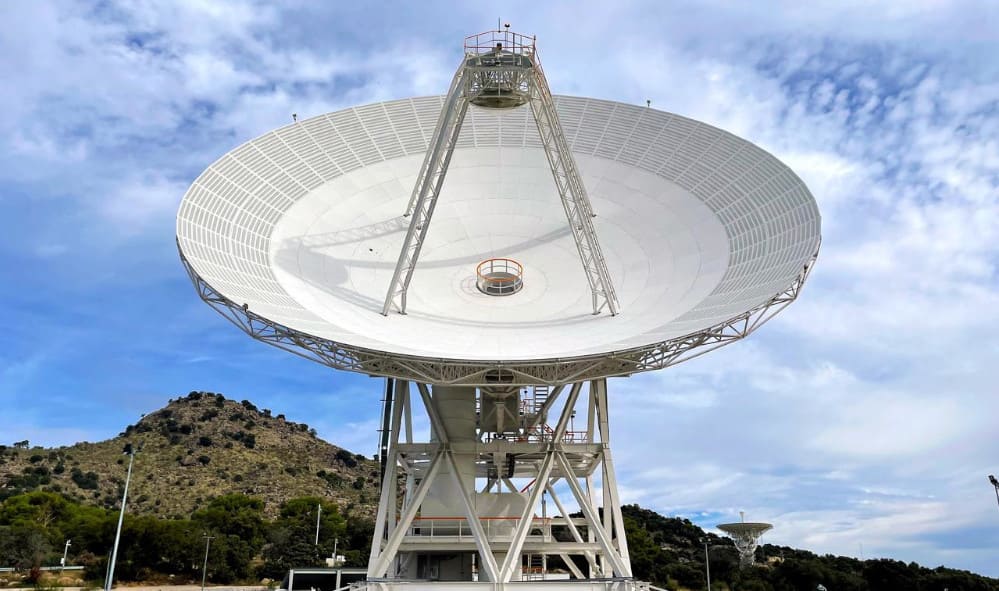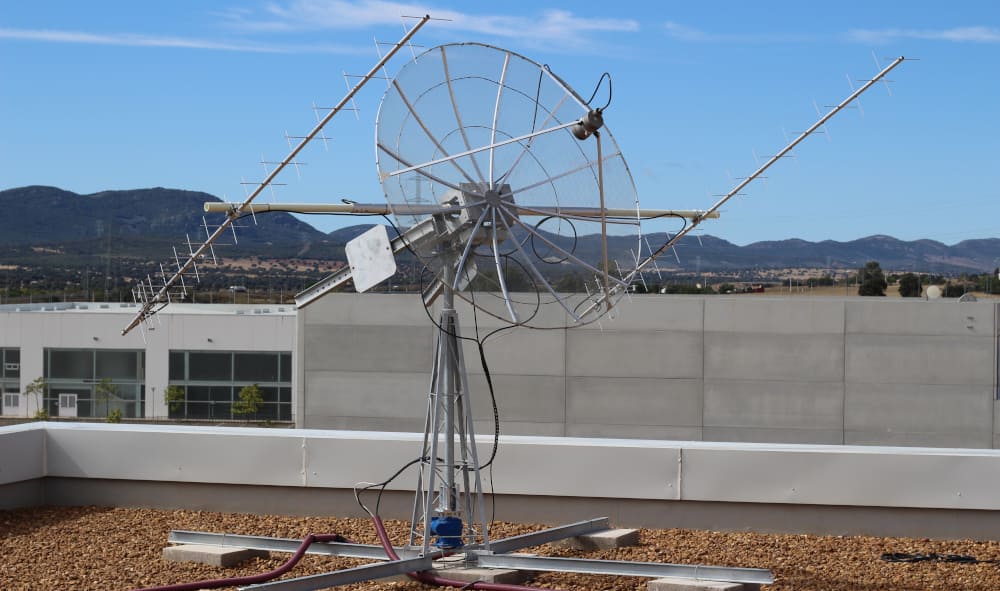
The intrinsic fear of losing connection with objects launched into space has been with agencies and companies since the space race was launched in 1957. Thanks to advances in space technology, especially with the revolution of New Space, communications for a satellite mission have taken giant steps towards full development.
What we know as the ground segment, i.e. the elements that currently make it possible to manage and control satellites from the ground and receive the information collected in space, have been refined and adapted to the requirements of new technologies.
Among the primary elements that form part of the basic ground segment scheme are ground stations. Through these telecommunication platforms, humanity has been able to make progress in relaying radio, television, telephony, internet and other data via satellite. And, of course, they play an important role in the deployment of Low Earth Orbit (LEO) satellites, where a variety of small satellites are located.
In this article, we will look at the minimum requirements for ground stations to be able to do their job effectively and what options are available to install an affordable and accessible solution for any type of mission.
Which capabilities are necessary for a satellite ground station?
As already mentioned, a ground station is understood as a facility capable of receiving, transmitting and controlling different communication signals, mainly from satellites of different sizes and intended for different applications: telecommunications, Earth observation or asset tracking, to name a few.
These stations vary according to the satellites with which the connection is to be established, since logically they do not need the same capabilities for tracking geostationary (GEO) satellites as for LEO orbit satellites. However, they must all start from the same basis to meet their objectives.

Photo: Government ground station for the Deep Space Network (DSN) and the exploration of the farthest reaches of the Solar System. Source: NASA.
Firstly, any ground station will be able to communicate with satellites in orbit, either unidirectionally or bidirectionally. In addition, there are certain factors that should be taken into account for the installation of an ground station:
- Design and technical specifications. There are certain technical and design requirements or parameters, such as transmission power, antenna gain, communication link quality, satellite tracking capability, etc.
- Antenna direction and alignment. It is essential that there is a configured alignment system that allows the link to be as direct as possible with the satellite in order to minimise losses in the connection.
- Signal processing. It is possible that the received signals may be weak or suffer some kind of distortion, so the station will always have digital signal processing (DSP) systems that filter, modulate, demodulate, encode or decode the information. In case errors or distortions are detected, extra correction methods will be applied.
- Frequency band selection. This is one of the most critical parts of the communication system, as both transmit (TX) and receive (RX) frequencies must be coordinated. In fact, ground stations can accommodate dual or triple bands. In general, the most commonly used for communication with satellites are Ultra High Frequency (UHF), Very High Frequency (VHF) and S-band.
- Monitoring and remote control. The software installed in the ground station will be able to communicate with the satellites by sending commands and receiving telemetry for monitoring their status and performance.
- Connection to terrestrial networks. The connection mode to the terrestrial network is decisive in the transmission of information from the satellites to other locations and vice versa. This may involve connection via wired networks, microwave links or other communication technologies.
- Data storage and processing. Ground stations must have the storage capacity and data processing systems to perform analysis and extraction of useful information.
- Safety and security. To ensure the integrity of operations and prevent possible interference or risks, certain aspects such as lightning protection, access control systems, data encryption, etc. are normally included.
Which location is common to install a ground station?
When determining the location of a small satellite tracking ground station, the various factors required for the space mission in question must be taken into account.
Apart from the peculiarities that each project may have, the most common locations are as follows:
- Remote or rural locations. These locations minimise potential electromagnetic interference and offer better visibility of the sky for communication with satellites. In addition, these areas tend to have fewer physical obstacles that hinder signal transmission.
- Elevated areas. Elevated terrain, such as hills or mountains, is preferable for ground stations. Being in a higher position gives a better line of sight to the satellite, which facilitates communication and reduces the possibility of signal blockage.
- Coastal areas. These locations are common in maritime and satellite applications for maritime communications. They also offer good visibility of the horizon and allow for efficient communication.
- Communications centres. In some urban or semi-urban areas, ground stations may be located in high-tech centres or technology parks. Adequate telecommunications infrastructure and reliable power services are essential.
In addition to this, there are technical requirements, local regulations, infrastructure availability and operational needs.
Which regulatory requirements are imperative for ground segment operation?
In general, small satellite ground stations are considered strategic or critical facilities not only by their owners but also by the relevant authorities. As such, they are subject to numerous regulations and standards applicable to safety, use of the radio spectrum, environmental protection, etc.
The requirements for obtaining a ground segment operating licence may vary depending on the jurisdiction of the country of installation and the type of operation. The vast majority of countries have a supervisory body or regulatory commission, and all are required to coordinate with the International Telecommunication Union (ITU).
Even so, there are a number of common conditions at this stage:
- Operating licence. A specific permit issued by the regulatory authority for the use of the radio frequencies and radio spectrum assigned to the ground station.
- Operability records. Adequate documentation and up-to-date records of ground station operations, including technical details, operating procedures, maintenance and test reports, as well as other documents, must be kept.
How can our Ground Station Kit (GS-Kit) help you to manage LEO satellites in commercial bands?
In addition to all the conditions listed above, there is also a very important one: feasibility. The development and operation of a space mission involves significant outlays, which is why, when it comes to installing a ground segment system, it always makes more sense to opt for the most viable and affordable option for the final project.
When looking for the supply of a ground station for tracking small satellite, it is necessary to select an option that includes all the necessary elements for its assembly and ensures its correct operation.
There are also many free and open source options for telemetry management and control software, although it is also possible to purchase paid software from specialised companies.
The democratisation of space technology has allowed the Alén Space team to gain a great deal of experience in the supply of ground segment solutions and in this way develop its own solutions in this area.
Alén Space's ground station (GS-Kit) allows an easy and quick installation of a ground station. Currently, two models are available: one of them is capable of operating simultaneously in UHF, VHF and S-band (RX), while the other is adapted to support S-band reception and transmission.
This solution includes the entire assembly structure (amplifiers, elevation and azimuth rotors, coaxial control and radio frequency cables and lightning protectors, among others), as well as the management and control software for the station itself.
In addition, Alén Space's ground segment services branch also includes the ground station transceiver, the SDR-Rack. A solution valid for the VHF and UHF bands or for S-band (TX, RX), compatible with GNURadio, an open-source tool for implementing signal processing in software-defined radio systems.

Photo: Ground Station Kit (GS-Kit) supplied to Deimos Engineering and Systems by Alén Space.
Although the efforts of any space mission must be spread across all phases, the ground segment is vital for operating the satellite and receiving the information coming from space. Therefore, the provision of a reliable and affordable solution for any type of project should be a priority in the pre-planning stage.
The Alén Space team can provide you with the necessary support in the installation and operation of ground segment solutions.








Stay in Touch